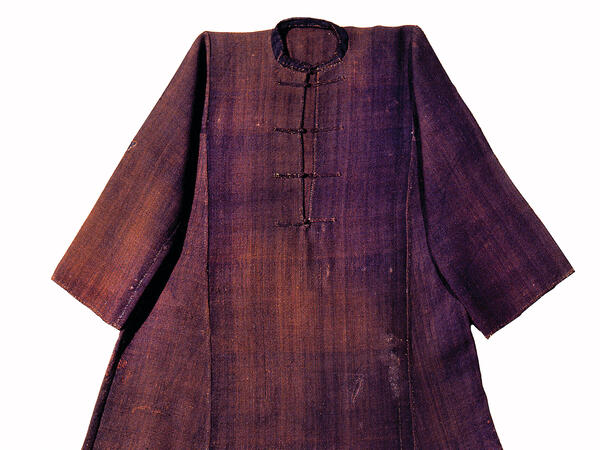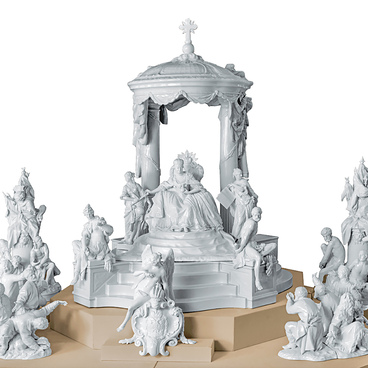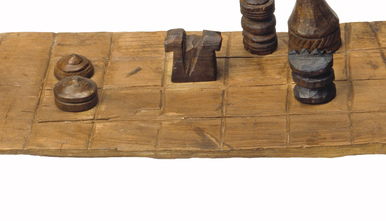The hairshirt is a long, large shirt that was made of coarse fabric, often with woven horse, goat or camel hair. It was worn by very devout Christians. The hairshirt was worn on the naked body under other items of clothing, often even at night. At the same time, the coarse fabric, wool and horsehair caused skin abrasions and wounds. Such traumas were considered noble: Christians believed that through pain they were cleansed from sins, emulating Christ’s suffering.
This monk’s clothing made of coarse wool fabric with woven horsehair belonged, according to a legend, to Tsar Ivan the Terrible. It was brought from Alexandrovskaya Sloboda (the modern city of Alexandrov, Vladimir Oblast) — the unofficial capital of the oprichnina, where the “Tsar’s Oprichnina Court” was located in 1564–1576.
In December 1564, Ivan IV left Moscow with his family, taking with him “his entire treasury”. The tsar was accompanied by his officials with their families and his army. A few weeks later, the tsar’s “train” arrived in Alexandrovskaya Sloboda, the ancient patrimony of the Moscow Grand Dukes. From there, Ivan IV sent two letters to the capital. In the first one, he announced his renunciation of the throne and wrote that he “placed his anger” on the boyars and clergy, who did not allow to execute traitors, and on the “children of the boyars” (serving landowners) for their disservice. In the second, addressing the citizens of Moscow, the tsar added that he had “no anger towards them”. Only after a petition of the clergy and the Duma, Ivan IV graciously agreed to return to the throne, but demanded to give him the right to “punish” the “disobedient” boyars without consulting the Duma and “implement the policy of oprichnina in his own state”. The Boyar Duma was forced to agree.
The term “oprichnina” derived from the word “oprich” meaning “except”, “apart from”. Originally, it was a term for the land left to a widow of a Grand Duke after his death. Ivan IV, thus, allocated for himself such land from the entire territory of the state. The country was divided into “Oprichnina” and “Zemshchina” territories. The Oprichnina of Ivan IV included all the palace lands, the northern regions with rich cities, the lands in the center of the country and borderlands. The nobles who were loyal to the tsar and formed his “Oprichniki” troops settled upon the oprichnina territory. Local landowners lost their ancestral patrimony and were forced to move to other parts of the country.
Alexandrovskaya Sloboda, which was turned into a fortress, became the unofficial capital of the oprichnina. It housed the “Tsar’s Oprichnina Court” — a military “fraternity”, the head of which was the tsar himself. The members of the “brotherhood” wore black clothes made of coarse fabrics and tied a kind of broom to their belt — a symbol of the oath to get rid of traitors. Oprichny Prikazy (prikaz — an administrative office) and the Boyar Duma were located at Alexandrovskaya Sloboda, as well as a print yard. Foreign embassies were also hosted there.
The lands that did not become part of the tsar’s oprichnina remained under the control of zemsky rulers (local authorities). Zemsky Prikazy and the Boyar Duma were still engaged in current state affairs. “Important matters” were reported to the tsar. He retained the position of the highest authority in court cases and in matters of international relations.
The Oprichnina went down in history as a period of mass repressions (when many prominent Russians of the 16th century were killed), the decline of Novgorod and Pskov, bloody massacres in Klin, Tver and Torzhok. Coupled with the long Livonian War, the Oprichnina caused a deep economic crisis that broke out towards the end of the reign of Ivan IV.
This monk’s clothing made of coarse wool fabric with woven horsehair belonged, according to a legend, to Tsar Ivan the Terrible. It was brought from Alexandrovskaya Sloboda (the modern city of Alexandrov, Vladimir Oblast) — the unofficial capital of the oprichnina, where the “Tsar’s Oprichnina Court” was located in 1564–1576.
In December 1564, Ivan IV left Moscow with his family, taking with him “his entire treasury”. The tsar was accompanied by his officials with their families and his army. A few weeks later, the tsar’s “train” arrived in Alexandrovskaya Sloboda, the ancient patrimony of the Moscow Grand Dukes. From there, Ivan IV sent two letters to the capital. In the first one, he announced his renunciation of the throne and wrote that he “placed his anger” on the boyars and clergy, who did not allow to execute traitors, and on the “children of the boyars” (serving landowners) for their disservice. In the second, addressing the citizens of Moscow, the tsar added that he had “no anger towards them”. Only after a petition of the clergy and the Duma, Ivan IV graciously agreed to return to the throne, but demanded to give him the right to “punish” the “disobedient” boyars without consulting the Duma and “implement the policy of oprichnina in his own state”. The Boyar Duma was forced to agree.
The term “oprichnina” derived from the word “oprich” meaning “except”, “apart from”. Originally, it was a term for the land left to a widow of a Grand Duke after his death. Ivan IV, thus, allocated for himself such land from the entire territory of the state. The country was divided into “Oprichnina” and “Zemshchina” territories. The Oprichnina of Ivan IV included all the palace lands, the northern regions with rich cities, the lands in the center of the country and borderlands. The nobles who were loyal to the tsar and formed his “Oprichniki” troops settled upon the oprichnina territory. Local landowners lost their ancestral patrimony and were forced to move to other parts of the country.
Alexandrovskaya Sloboda, which was turned into a fortress, became the unofficial capital of the oprichnina. It housed the “Tsar’s Oprichnina Court” — a military “fraternity”, the head of which was the tsar himself. The members of the “brotherhood” wore black clothes made of coarse fabrics and tied a kind of broom to their belt — a symbol of the oath to get rid of traitors. Oprichny Prikazy (prikaz — an administrative office) and the Boyar Duma were located at Alexandrovskaya Sloboda, as well as a print yard. Foreign embassies were also hosted there.
The lands that did not become part of the tsar’s oprichnina remained under the control of zemsky rulers (local authorities). Zemsky Prikazy and the Boyar Duma were still engaged in current state affairs. “Important matters” were reported to the tsar. He retained the position of the highest authority in court cases and in matters of international relations.
The Oprichnina went down in history as a period of mass repressions (when many prominent Russians of the 16th century were killed), the decline of Novgorod and Pskov, bloody massacres in Klin, Tver and Torzhok. Coupled with the long Livonian War, the Oprichnina caused a deep economic crisis that broke out towards the end of the reign of Ivan IV.



